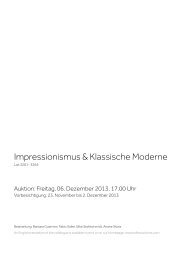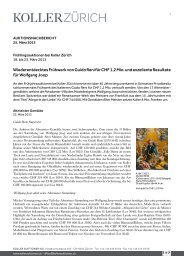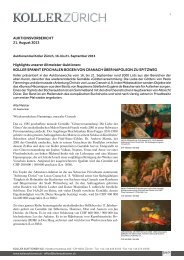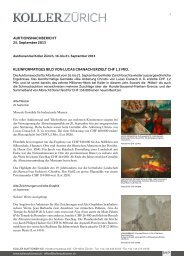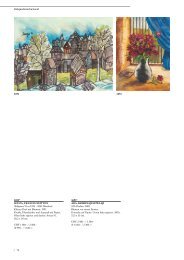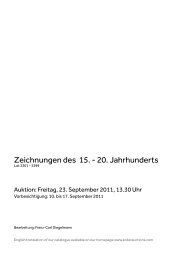PDF Katalog - Koller Auktionen
PDF Katalog - Koller Auktionen
PDF Katalog - Koller Auktionen
Erfolgreiche ePaper selbst erstellen
Machen Sie aus Ihren PDF Publikationen ein blätterbares Flipbook mit unserer einzigartigen Google optimierten e-Paper Software.
13). Not only Emperor Maximilian I, but also<br />
"anyone who was regarded somewhat or availed<br />
themselves of the Wittenberg painter's services."<br />
(see ibid.)<br />
It is probable that our exquisite wooden panel<br />
was purchased by a wealthy art lover. Its subject,<br />
the "Adoration of Christ," would surely<br />
have appealed to secular patrons. Because of its<br />
diminutive size it may have been used for private<br />
devotion and could have been taken on journeys.<br />
But its excellent state of preservation suggests,<br />
rather, that a connoisseur acquired this<br />
small treasure by the famous court painter for<br />
his art collection. Possibly, the collector valued<br />
the extremely careful rendering of the surfaces<br />
depicted, so characteristic of Cranach, which<br />
are elaborated in our "Adoration" down to the<br />
finest details. Mary's veil, painted in gossamer<br />
white; the blurring of the velvety clouds; and<br />
the animals' fur, spotted and enlivened with the<br />
tiniest brush strokes; demonstrates his mastery<br />
as much as the brilliant colours. In fact, modern<br />
research into Cranach's oeuvre has detected no<br />
fewer than 30 different pigments and numerous<br />
experiments with different underpaintings for<br />
his subjects, undertaken in the artist's search for<br />
perfection in painting.<br />
The Mother of God, immersed in worship, literally<br />
forms the centre of the picture. Her head is<br />
not only placed exactly in the middle of the<br />
scene, but through it passes a line connecting<br />
two beings that shine in heavenly splendour: the<br />
infant Jesus and an apparition in the upper right<br />
background. In a gleaming aureole this angel<br />
hovers with a scroll in his hands to announce<br />
the birth of the Saviour to the steadfast shepherds<br />
with their herds. At the same time, he<br />
reminds us of the Archangel Gabriel's earlier<br />
Annunciation to the Virgin that she would give<br />
birth to the Son of God. Through her body,<br />
kneeling in the manger between the angel in<br />
heaven and the infant Jesus in his earthly crib,<br />
this promise is now fulfilled.<br />
The intimacy of the silent communication between<br />
mother and child is touching. Mary's skin<br />
has the same porcelain-like delicacy as the<br />
naked body of the baby Jesus, which glows<br />
from within. So intense is her absorption in the<br />
boy's divinity that she, like the beloved, is not<br />
touched by the cold of their environment. The<br />
frost has already coloured Joseph's nose and<br />
cheeks bright red while he kneels beside Mary.<br />
At the back right, a shepherd indicates the baby<br />
Jesus with his gloved hand; the other two huddles<br />
close together, their hands under their caps<br />
for warmth. The cool colours, the bare ground<br />
and the stone trough emphasize the harshness<br />
and barrenness of the place where the miracle<br />
occurs.<br />
In the upper left corner of our wooden panel is a<br />
kind of cloud swing bearing a group of angels: a<br />
confusion of wings, tiny hands and small heads<br />
that relieves the theological gravity of the scene<br />
delightfully. The winged cherubs are not truly<br />
engaged, in fact; not one turns his attention<br />
directly to the scene of adoration before them.<br />
Some are looking around within this world history;<br />
others seem to confront us directly as the<br />
viewer. The playful little angels are a motif that<br />
Lucas Cranach takes up again and again throughout<br />
his decades of work. In the renowned<br />
painting "Holy Family in a Landscape" of 1504,<br />
also known as "Rest on the Flight"<br />
(Gemäldegalerie, Berlin), we can already see the<br />
angels fetching water, playing music and even<br />
watching the bird catching. Even in the very<br />
solemn Lutheran instructional picture "Law and<br />
Grace" of 1529 (Národní Galerie, Prague), they<br />
do mischief. "Only in exceptional cases is their<br />
attention given to the true protagonists directly,"<br />
attests the exhibition catalogue (Brussels 2011,<br />
p. 121); "Otherwise, these adorable little attendants<br />
busy themselves according to their childlike<br />
natures."<br />
The theme of the Adoration of Christ appears<br />
in four other paintings by the master, three of<br />
which are dated to the 1520s (see Friedländer,<br />
Max/Rosenberg, Jakob: The paintings of Lucas<br />
Cranach, London, 1932/1978, p. 90, nos. 101<br />
-103). That version listed in Friedländer/<br />
Rosenberg as no. 101, dated around 1515-20,<br />
belongs to the Dresden State Art Collections<br />
(Old Masters Picture Gallery) and was part of<br />
the great Cranach exhibition at the Städel<br />
Museum in Frankfurt and at the Royal<br />
Academy of Arts, London, in 2008 (see<br />
Brinkmann, Bodo (ed.): Cranach the Elder,<br />
Ostfildern 2007, exh. cat., Städel Museum,<br />
Frankfurt am Main, 23.11.2007 - 17.2.2008,<br />
Royal Academy of Arts, London, 8.3 -<br />
8.6.2008, no. 15, p. 142, colour illustration). In<br />
this variant, Cranach illustrates a vision of St.<br />
Bridget of Sweden, in which the light emanating<br />
from the newborn outshines that of a<br />
candle. For the optimal representation of this<br />
effect Cranach placed the figures in a stable at<br />
night. In our scene, played out during the day,<br />
he instead emphasizes the glow radiating from<br />
the Christ child, which warms his mother. Both<br />
variants suggest the special role of Mary in the<br />
history of salvation through the imaginary line<br />
between the preaching angel and Jesus. The<br />
three shepherds leaning on a wall are also found<br />
in Friedländer/Rosenberg, listed as no. 103, and<br />
also in a version dated to 1518-20 (privately<br />
owned). Another version, published in<br />
Friedländer/Rosenberg as no. 102, also employs<br />
the stone trough aligned with the back.<br />
However, in this work the very schematic treatment<br />
of the masonry and stone floor, as well as<br />
the attendant putti, is striking. This Christmas<br />
scene is housed at Knightshayes Court in<br />
Devon, United Kingdom, where it is preserved<br />
by the National Trust, and is attributed today to<br />
the Cranach workshop.<br />
Produced around 1535, Cranach's "Holy Night"<br />
in the Erfurt museum is ultimately most similar<br />
both compositionally and stylistically to our picture,<br />
which suggests that it can be dated to the<br />
master's late period. In the Erfurt version, the<br />
infant Christ also lies in a stone trough placed at<br />
the centre, surrounded by Mary and Joseph<br />
kneeling in prayer. The crouching ox and donkey,<br />
whose eyes engage the viewer and invite<br />
them into the action, are comparable with those<br />
of our panel, as well as the shepherds found at<br />
the right and the throngs of angels in the upper<br />
half of the picture.<br />
Dr. Dieter Koepplin, who has known our<br />
"Adoration of Christ" from a previous appraisal,<br />
reaffirms the attribution to Cranach the Elder in<br />
a letter dated 16.3.2013, and suggests that our<br />
panel was created in the period of 1545-50. He<br />
compares the execution of specific details, such<br />
as the description of the hair, to the painting<br />
"The Fountain of Youth," dated to 1546 and<br />
now in the Gemäldegalerie, Berlin.<br />
CHF 400 000.- / 600 000.-<br />
(€ 333 330.- / 500 000.-)<br />
| 33



